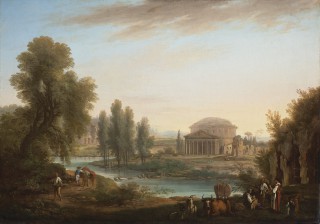Italian Landscape with Rotunda
- Date
- 1746
- Object type
- painting
- Technique
- oil
- Material
- canvas
- Dimensions
- 53,0 x 74,5 cm
- Acquisition date
- 1783
- Location
- The Palace on the Isle - Picture Gallery, ground floor
- Place of Origin
- France (Europe)
- Owner
- The Royal Łazienki
- Museum number
- ŁKr 839
The 1967 catalogue of the National Museum in Warsaw quotes the signature which was visible in the bottom right corner: Duflos fe./ 1746 … .
Duflos gained a reputation primarily as an engraver; he made several series of etchings with views of Rome and Florence which were published by prestigious printing houses. ... His etchings were characterized by technical mastery, subtlety and lightness of lines, and an elegiac, poetic atmosphere evoking an idealized picture of antiquity. This manner of viewing the ancient past, developed in the 17th century, by French artists active in Rome—Claude Lorraine, Nicolas Poussin and Gaspard Dughet—found its followers in Roman circles in the first half of the 18th century, among engravers and painters at the Académie de France in Rome, where Duflos was active. The Łazienki painting is an excellent example of this trend. The artist depicted a round building in an expansive, idyllic landscape suffused in the rosy light of the setting sun. The building’s architecture alludes to the Pantheon in Rome—however, not as it looked in the artist’s lifetime, but as we know it from 16th-century engravings: with a rotunda with marble cladding and pilasters, and also from the paintings of Claude Lorraine. Duflos intentionally alludes to the works of his great compatriot, such as e.g. Landscape with Aeneas in the National Gallery, London ... , in which a similar building, although more slender in proportions, is represented as the Temple of Apollo. [See D. Juszczak, H. Małachowicz, The Stanisław August Collection of Paintings at the Royal Łazienki. Catalogue, Royal Łazienki Museum, Warsaw 2016, no. 40, pp. 170–171.]





